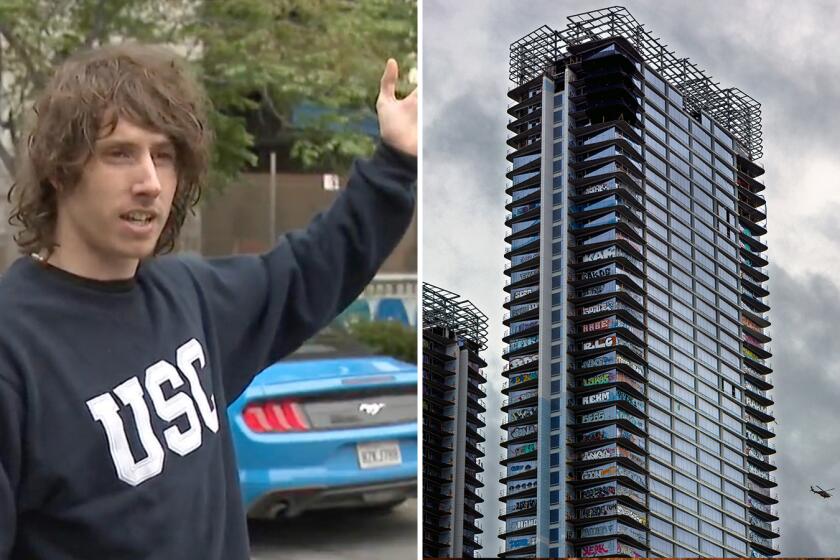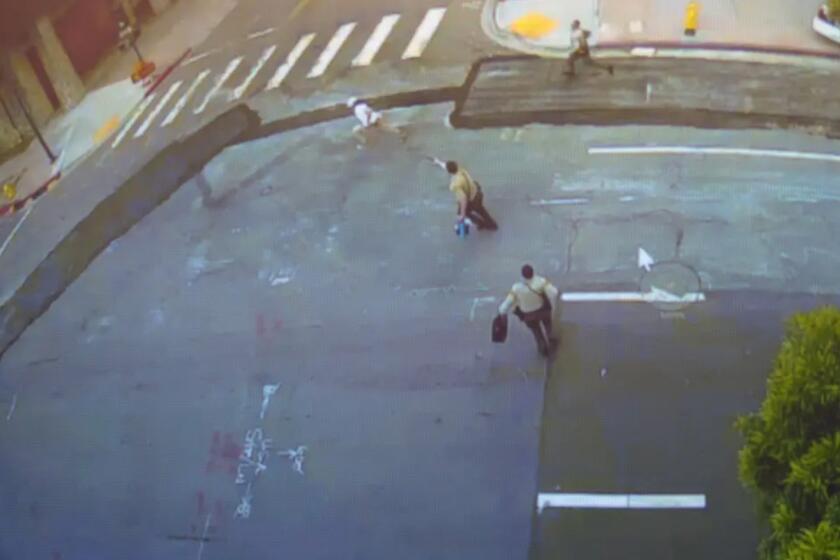‘Graffiti Art’ Panned : Huntington Beach Council Votes to Kill Controversial Seawall Project
So-called “graffiti art” has gotten the brushoff from the City Council, which heeded arguments from police who charge that the program led to an increase in illegal tagging.
After a long and contentious meeting that didn’t end until after midnight, the council voted 6-1 early Tuesday to end the city’s controversial Sea Wall Art Program. That program, begun about a year and a half ago, allowed people to get free city permits to paint on seawalls near the beach. The program apparently was the only one of its kind in the state.
Officials said that within the next 30 days letters will be mailed to the 700 permit holders, notifying them no more painting will be allowed on the walls. All of the existing artworks also will be painted over in the next month.
Some graffiti artists continued painting on Tuesday, and city officials said they would allow a phase-out period. One artist at work Tuesday was Robert Gomez, 18, of Torrance, who said he is disappointed at the council’s action.
“They gave us a place to do this, and then they took it away,” Gomez said. “I don’t think they gave anyone a chance.”
Gomez was painting large letters: CBS--which he said stands for “Can’t Be Stopped.”
But earlier Tuesday, the City Council had said the art program could, and would, be stopped. The council’s vote at 12:20 a.m. came after an emotional public hearing, during which about 25 people spoke for or against the program. Many of those who testified were colorfully dressed young men and women who called themselves graffiti artists.
“To us graffiti artists, this is our Disneyland,” Marcello Mercado, 19, of Norwalk told the council. “No city except Huntington Beach has ever had a program like this.”
Some of the seawall paintings have been mainstream art, such as traditional scenes of surfing and beach games. But other paintings have been spray-applied graffiti, which caused most of the controversy.
Police and several community activists charged that the graffiti artists did not limit their work to the seawalls but also illegally sprayed buildings and houses in the city.
Supporters of the program said police never proved their contention that seawall artists vandalized parts of Huntington Beach. They argued that the program unfairly was made a scapegoat for alarm about increased graffiti throughout Orange County.
“There is no substantiated proof that the walls have been the cause of the increase in graffiti,” said Gerald Chapman, a director of the Huntington Beach Art Foundation. He pleaded unsuccessfully with the council to preserve the program. “Please do not eliminate this pioneering program because of unsubstantiated rumors.”
Program opponents argued that it is an experiment that had failed. They said the city could ill afford to keep up a plan that might be encouraging illegal graffiti.
Jan Shomacker, a former city planning commissioner, told the council that police correctly oppose the art program because it has made anti-graffiti enforcement difficult. “It allows children to run around with spray cans,” she said. “We’ve tried the program. It doesn’t work.”
Another opponent, Brian Bridges, a member of the citizen group Community Forum of Huntington Beach, said that most of the artists using the walls are not residents of the city. He and others asked why Huntington Beach taxpayers should subsidize an art program for out-of-towners.
Dave Karina, a resident, had a similar argument. “The people in Huntington Beach do not like the seawall program,” Karina added.
But supporters argued that the seawall program was very popular both in the city and as a statewide magnet for artists.
Jason Olson, 18, told the council he drives to Huntington Beach from his home in San Diego to paint on the seawalls. He said he needed a place to practice his art. “If you don’t continue this program, I’m going to have to go to the streets with it (graffiti art),” he said.
Another youth, Jason Cruz, 21, of Riverside, told the council he had found the seawalls a legal haven for his painting after having been put on probation for a graffiti-related arrest in Riverside.
Victoria Martinez, 18, of Long Beach said: “The walls are very important; they unite the culture. They unite the art form.”
After the three-hour public hearing, the council debated the program’s fate.
Councilman David Sullivan was the only member who spoke in favor of keeping the program as it has existed. Councilman Victor Leipzig proposed banning spray cans and marker pens from the walls and instead permitting only traditional brush-art painting. Leipzig dropped his proposal, however, after a city staffer said that type of program would be difficult to enforce.
Most members of the council said they were swayed by Police Chief Ronald E. Lowenberg’s position. Lowenberg, in comments earlier this year, said the program had hampered police efforts to reduce illegal graffiti.
“Our police chief is not heavy-handed in his approach to law enforcement,” said Councilman Ralph Bauer. “When a chief of police like him says there is a problem, I have to believe him.”
On the final vote, Sullivan cast the lone tally opposing the motion to discontinue the program.
More to Read
Start your day right
Sign up for Essential California for news, features and recommendations from the L.A. Times and beyond in your inbox six days a week.
You may occasionally receive promotional content from the Los Angeles Times.






